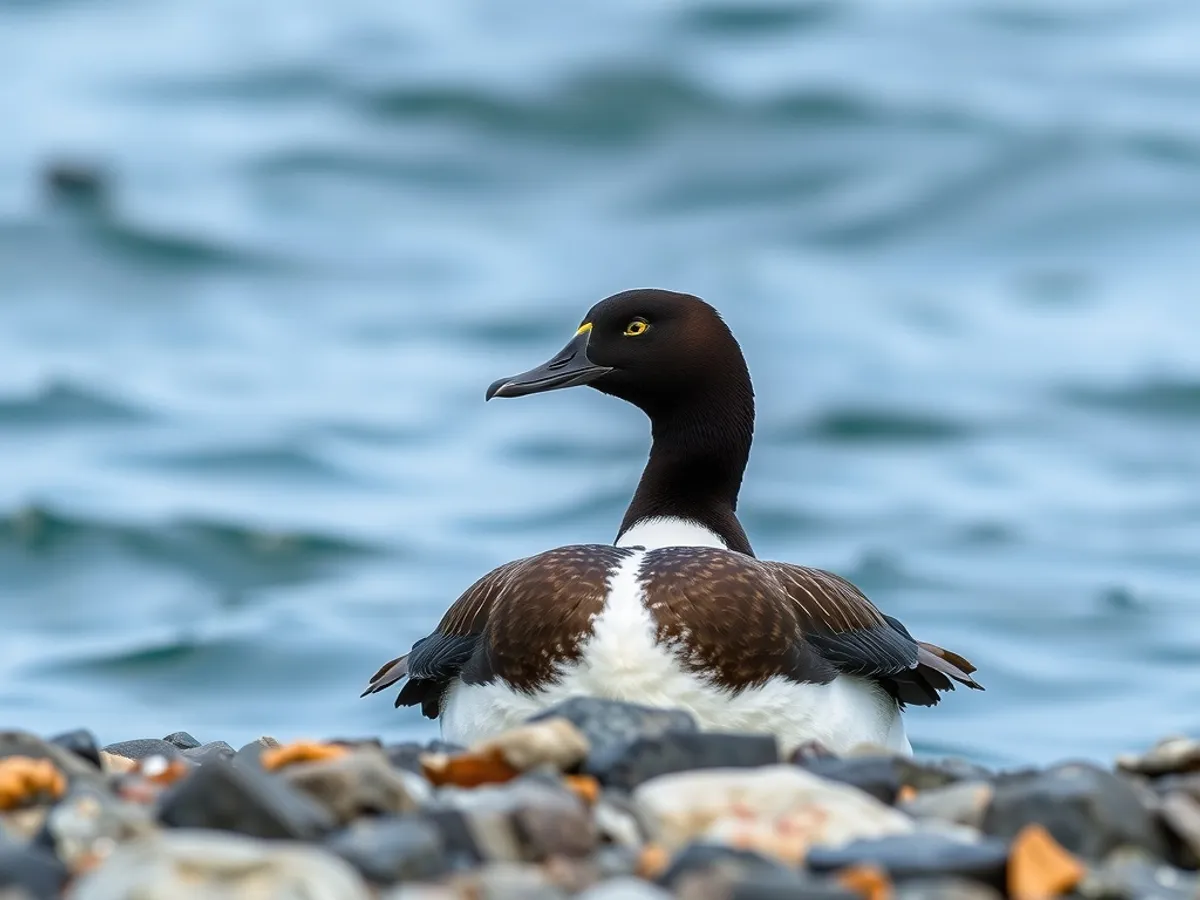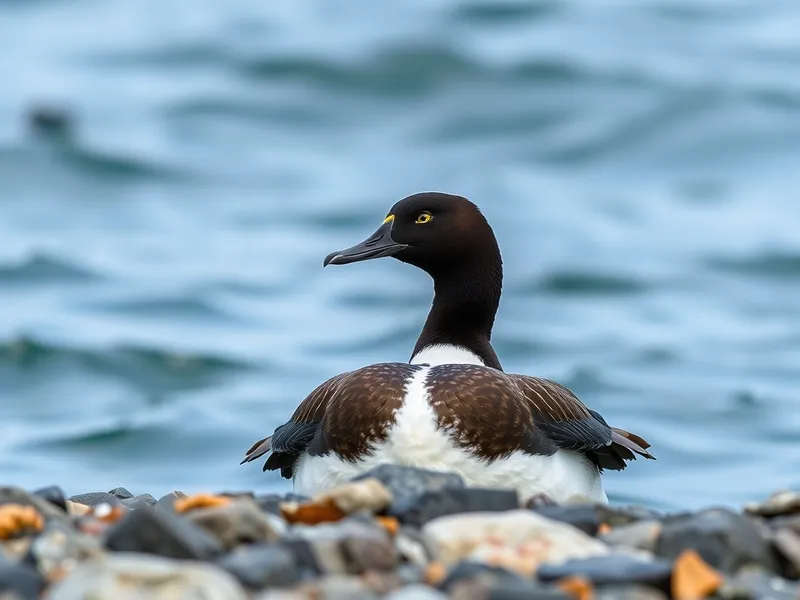
Common Eider
Somateria mollissima

Meet the Common Eider
The Common Eider is a large sea duck found along the northern coasts of Europe, North America, and eastern Siberia. Males are strikingly colored with bold black and white plumage and greenish napes, while females are mottled brown for camouflage during nesting. Renowned for their soft down, eiders gather in dense colonies on coastal islands and feed primarily by diving for mollusks and crustaceans. Their nests are lined with eiderdown, which is highly sought after for its insulating properties. These social birds are well adapted to cold marine environments and can often be seen floating in flocks near the shore.
Classification
Bird
Habitat
Coastal marine environments, rocky seashores, and islands in subarctic and arctic regions
Diet
Carnivore
Lifespan
10-20 years
Conservation
Least Concern
Weight
1.2–2.8 kg
📖Fascinating Facts
Supreme Insulator
Eiderdown, collected from the nests of Common Eiders, is considered the warmest and lightest natural insulation used in luxury bedding and clothing.
Diving Duck
Common Eiders are expert divers, often reaching depths of up to 20 meters (65 feet) to forage on the seafloor for mussels, clams, and other marine invertebrates.
Duckling Daycare
Female eiders frequently form cooperative groups, or 'crèches,' where multiple hens look after the ducklings, increasing the young birds' survival chances.
📋Detailed Description
The Common Eider (Somateria mollissima) is the largest duck species in the Northern Hemisphere, with adult males measuring 50–71 cm in length and weighing 1.2–2.8 kg, while females are slightly smaller. Males in breeding plumage display striking black and white coloration with a pale green nape, whereas females are cryptically mottled brown, providing camouflage during nesting. Both sexes have a distinctive wedge-shaped bill, adapted for prying mollusks from rocks. Eiders possess dense, waterproof plumage and a thick layer of insulating down, which is renowned for its exceptional warmth and buoyancy. They are highly gregarious, forming dense colonies during the breeding season and large flocks in winter, sometimes numbering in the tens of thousands. Their powerful, direct flight is supported by long, pointed wings, allowing speeds up to 113 km/h (70 mph). Eiders are primarily benthic feeders, diving to depths of up to 20 meters to forage. Their vocalizations are generally soft coos and grunts, with males producing a distinctive 'ah-ooo' call during courtship. The species is well adapted to cold marine environments, often remaining in icy waters throughout the year.
💡 Did you know?
Eider females sometimes share parental duties, forming 'crèches' where several hens tend to their ducklings together.
🔬Research & Sources
Wikipedia Summary
The common eider, also called St. Cuthbert's duck or Cuddy's duck, is a large sea-duck that is distributed over the northern coasts of Europe, North America and eastern Siberia. It breeds in Arctic and some northern temperate regions, but winters somewhat farther south in temperate zones, when it can form large flocks on coastal waters. It can fly at speeds up to 113 km/h (70 mph).
Last Modified: 5/24/2025
🎭Behavior & Social Structure
Common Eiders are diurnal, spending daylight hours foraging and resting in flocks on open water or along rocky coasts. They are skilled divers, using their large webbed feet to propel themselves underwater in search of prey, mainly blue mussels (Mytilus edulis), sea urchins, crustaceans, and occasionally small fish. Eiders often feed in synchrony, forming loose groups that dive and surface together. Social structure is complex, especially during breeding, with females forming 'crèches'—groups where multiple hens jointly care for ducklings, increasing survival rates. Outside the breeding season, both sexes are highly social, forming large, mixed flocks. Eiders are relatively sedentary, showing strong site fidelity to both breeding and wintering grounds. Daily routines include preening, bathing, and resting on water or exposed rocks.
👶Reproduction & Life Cycle
Breeding occurs from late May to July, depending on latitude. Males perform elaborate courtship displays, including head-throwing and vocalizations. Eiders are mostly monogamous within a breeding season, though pair bonds may not persist year to year. Females select nest sites on coastal islands, often in dense colonies, and line their nests with down plucked from their own breasts. Clutch size ranges from 3 to 6 pale olive eggs. Incubation lasts 25–28 days and is performed solely by the female, who fasts during this period. Ducklings are precocial, leaving the nest within 24 hours of hatching and heading to water, where they are cared for by the mother and sometimes by multiple females in communal broods. Fledging occurs at 65–75 days, but young eiders remain vulnerable to predation and harsh weather.
🛡️Adaptations & Survival
Common Eiders exhibit several adaptations for cold, marine environments. Their dense, waterproof feathers and thick layer of eiderdown provide exceptional insulation, allowing them to remain in frigid waters. Salt glands above the eyes excrete excess salt, enabling them to drink seawater. Their wedge-shaped bills are specialized for prying open mollusks, and their strong, webbed feet aid in efficient diving. Behavioral adaptations include colonial nesting for predator defense and communal brood-rearing to increase duckling survival. Eiders are also capable of reducing metabolic rates during fasting periods, such as incubation.
🎨Cultural Significance
The Common Eider has long been valued for its down, which is harvested sustainably in some regions (notably Iceland and Norway) without harming the birds. Eiderdown is considered the finest natural insulator and has been used in bedding for centuries. The species is associated with St. Cuthbert, an Anglo-Saxon saint, leading to the nickname 'Cuddy's duck.' Eiders feature in northern European folklore and have been depicted in art and literature as symbols of coastal wilderness and resilience.
🔬Recent Research & Discoveries
Recent research has focused on the effects of climate change on eider breeding phenology and chick survival, as well as the impact of marine pollution on health and reproductive success. Genetic studies have clarified subspecies relationships and migration patterns, revealing limited gene flow between some populations. Ongoing studies are examining the sustainability of down harvesting and the role of communal brood-rearing in chick survival. Notably, eiders have been used as model organisms for studying the energetics of fasting and thermoregulation in birds.
🎥Wildlife Videos

Brants (Atlantic), buffleheads, and a Common Eider
In the Chesapeake Bay just off Fort Monroe, Hampton Roads, Virginia. February 28, 2019. The common eider is an immature ...
Chuck Schussman

The Ultimate Guide to Duck Comparisons and Battles: Fascinating World of Waterfowl: WanderWildlife
Today I am discussing about the Ultimate Guide to Duck Comparisons and Battles: The Fascinating World of Waterfowl: ...
Wanderwild Life

King Eider vagrant visiting Sweden in April 2021
I was so lucky this male King Eider was stationary long enough for me and my partner getting to see it, and that the distance to the ...
Hummingbirder1

Jal murgi water han moorhans And Common eider chick🐧🐦🐤🦆🪿🦇
coman edar dishcriptianImmature and nonbreeding males are chocolate brown with variable white on the breast and back.
Pahadi revasi

The famous Eider duck Colony in Longyearbyen, Svalbard - a tourist attraction is about to disappear
Ep10. One of the most popular tourist attractions in Longyearbyen, Svalbard in the high Arctic is about to be destryed due to failed ...
Best Wildlife Stories

Eider Ducks of Northumberland
Northumberland's Eider Ducks are of high conservation importance but also have strong cultural links thanks to their association ...
Berwickshire and Northumberland MNP
🌍Habitat Information
The Common Eider typically inhabits Coastal marine environments, rocky seashores, and islands in subarctic and arctic regions environments. Common Eiders have adapted to their environments with specialized features and behaviors.
Primary Habitat:
Coastal marine environments, rocky seashores, and islands in subarctic and arctic regions
More detailed habitat information will be available soon.
🛡️Conservation Status
The Common Eider is currently classified as Least Concern. Conservation efforts are crucial for preserving this species for future generations.
Common Threats:
- 🏠Habitat loss and fragmentation
- 🌡️Climate change impacts
- 🎯Hunting and poaching
- 🏭Human-wildlife conflict
⚠️Threats & Conservation Challenges
Major threats to Common Eiders include oil spills, entanglement in fishing gear, overharvesting of eggs and down, and predation by introduced mammals (e.g., foxes, rats) on breeding islands. Climate change poses additional risks by altering prey availability and increasing storm frequency, which can flood nests. While global populations are currently classified as Near Threatened by the IUCN, some regional populations have experienced significant declines due to habitat disturbance, pollution, and disease outbreaks (e.g., avian cholera). Conservation challenges include protecting breeding colonies, regulating down collection, and mitigating human disturbance.
🔬Scientific Classification
Scientific Name
Somateria mollissima
Classification Hierarchy
🔍 About Taxonomic Classification
Taxonomic classification is a hierarchical system used by scientists to classify and organize living organisms based on shared characteristics and evolutionary relationships.
The system moves from broad categories (Kingdom) to increasingly specific ones, with each animal's scientific name typically consisting of its Genus and species.
📝Community Notes
Share your observations and insights about the Common Eider with our community of wildlife enthusiasts.
Join Our Community
Sign in to share your observations and connect with fellow wildlife enthusiasts.
Sign In to ContributeNo community notes yet
Be the first to share your observations about the Common Eider!
Explore Common Eider
Select a tab above to learn more about this amazing animal.
📸Photo Gallery
No photos available for this animal yet.
🌟Discover More Wildlife
Continue your journey of discovery with more fascinating animals from our database
